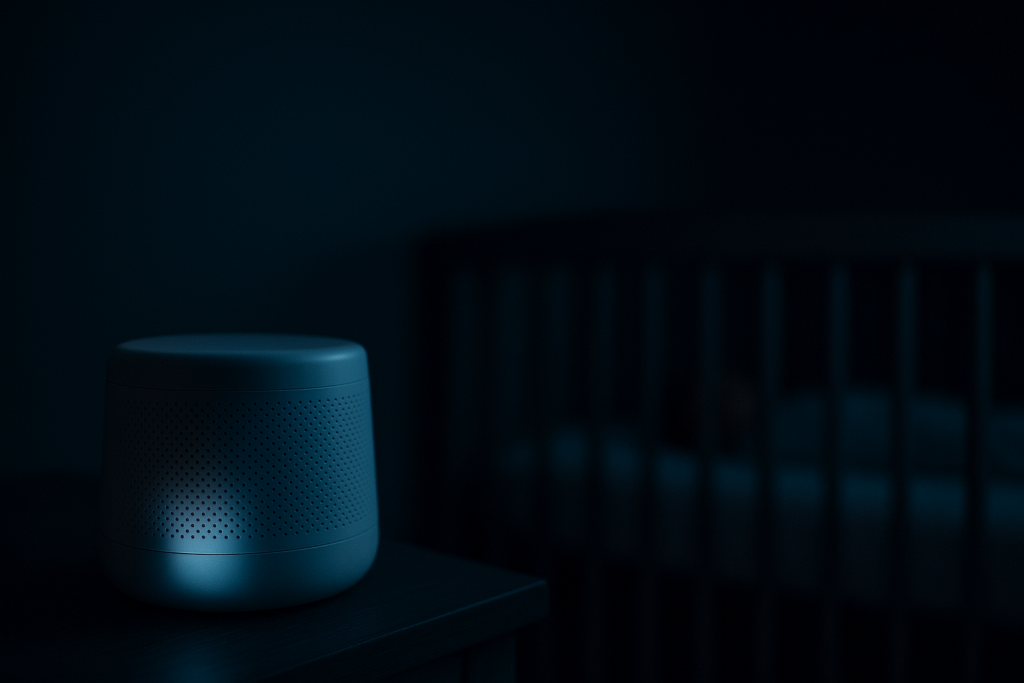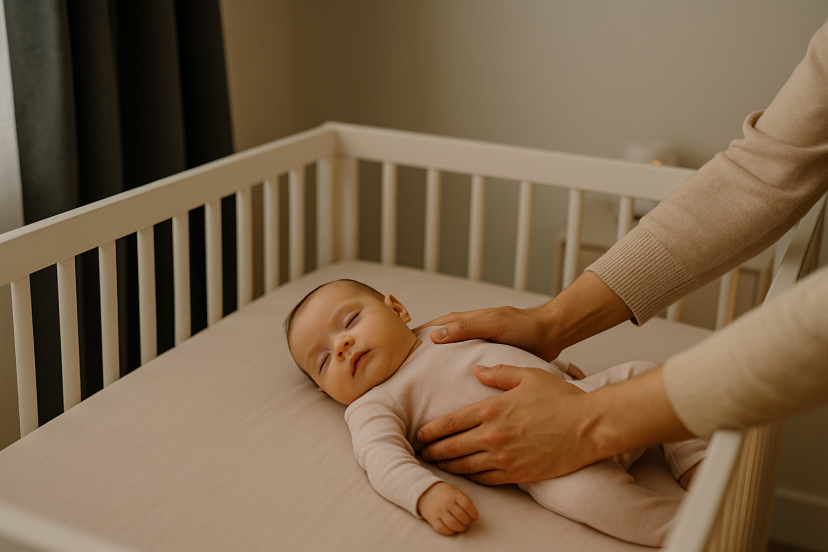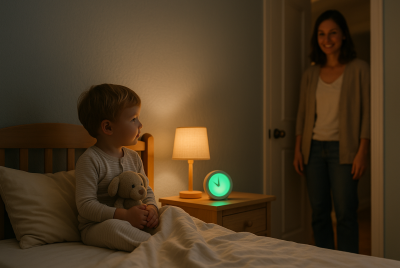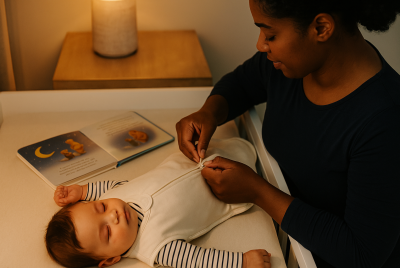5 Tips To Get An Overtired Baby To Sleep Faster
We may earn a commission for purchases made using our links. Please see our disclosure to learn more.
If you’re holding an overtired baby who keeps rubbing tiny eyes yet refuses to settle, you’re not alone. When babies tip past their “sweet spot,” sleep gets harder, not easier. In this guide, you’ll learn exactly what “overtired” means, how to spot it early, and the five most reliable ways to reset sleep—plus gear that actually helps and research you can trust. (If you use any of the recommended products below, quick note: we may earn a small commission at no extra cost to you.)
What “Overtired Baby” Really Means
An overtired baby has stayed awake past their optimal window, so their stress hormones (like cortisol) kick in. That surge makes them wired and fussy, even while their body desperately wants sleep. It’s why your sleepy newborn can suddenly look “wide awake” and fight the crib. Pediatric sources describe how missed sleep windows and stimulation can trigger a stress response that blocks settling and keeps waking cycles choppy.
Spot the Early Sleep Cues (Before Overtired Hits)
Watch for the quiet cues first: zoning out, slow blinks, looking away, pink eyebrows, lower activity. Then the louder cues arrive: fussing, arching away, frantic crying, and difficulty settling. If you respond during the quiet phase, your success rate skyrockets. Trusted sleep resources list yawning, eye rubbing, and staring as classic “it’s time now” signals—your nudge to dim lights and start the wind-down.
The Science: Why Overtiredness Makes Sleep Hard
Sleep pressure builds across a wake window. When we overshoot, stress chemistry rises and babies lose the self-regulation they need to fall and stay asleep. Circadian rhythm (the body clock) also plays a role—it gradually emerges around 2–4 months as melatonin production ramps up, which is why nights become more predictable with age.
Calming Reset: A 10-Minute Wind-Down That Works
Think of this like an airplane landing—slow, steady, predictable:
- Minutes 1–3: Lights low, diaper check, gentle top-off feed if hunger is likely.
- Minutes 4–6: White noise on; soft sway or walk while baby’s head rests near your heart.
- Minutes 7–8: Sit and still. Keep the same hold so the motion fades gradually (a trick many pediatricians love).
- Minutes 9–10: Transfer to the safe sleep space drowsy-but-awake; keep white noise running.
Parents and pediatric sources often recommend dimming stimuli, using consistent sounds, and ensuring baby isn’t hungry right before you try to settle.
Wake Windows That Actually Work
Use age-appropriate wake windows as guideposts, not rigid rules. For many newborns, 45–90 minutes is plenty; as babies grow, windows lengthen. The magic is noticing when your baby’s cues consistently appear—then starting your routine just before those cues. Reputable sleep education sources outline typical windows and early signs (crying, yawning, eye-rubbing) that mean it’s time.

Build a Gentle Bedtime Routine (That Sticks)
A short, consistent routine signals the brain that sleep is coming. Research shows that evening routines are associated with shorter sleep onset and fewer night wakings in infants and toddlers. Even better, improvements can start within the first three nights when families implement a routine. Try bath → feed → book → cuddles → white noise → bed.
Swaddling & Safe Sleep Basics
Swaddling can reduce the startle reflex in young babies; as they show rolling signs, transition to an arms-out sleep sack. Always follow safe sleep guidelines: place baby on the back, on a firm, flat surface, in their own sleep space free of loose items. The American Academy of Pediatrics summarizes the 2022 safe sleep recommendations and technical report for reducing sleep-related infant deaths.
Want a gentle step-by-step on secure, comfy swaddling? See this friendly primer: newborn swaddling basics on ZzzyBaby. (It’s a quick, visual walkthrough tailored for new parents.)
White Noise & Light: Set the Room for Sleep
Soft, continuous white noise can mask sudden household sounds and cue relaxation. Keep the room dark (especially for naps), because bright light suppresses melatonin and signals “time to be awake.” Portable blackout shades are a lifesaver for travel or bright rentals, and white noise + darkness is a powerful combo when you’re rescuing an overtired day. Evidence-based circadian guidance supports limiting bright light before sleep and aligning light exposure with desired sleep timing.
Feeding & Comfort: Top-Offs, Pacifiers & Contact
An overtired baby might also be a hungry baby. Offer a brief top-off feed if it has been a while. Many newborns settle with a pacifier—especially during that last quiet swaying minute. If baby needs body contact to reset, try a contact nap to catch up, then aim for a crib nap next cycle. Practical pediatric guidance frequently recommends ruling out hunger first, then creating a calm, dark environment to settle.
Motion vs. Stillness: When Baby Fights Sleep
Gentle rocking or walking can help an overtired newborn, but phase the motion down before the crib transfer so you’re not stuck pacing all night. Try the walk-then-sit trick (move for five minutes, sit still for eight, then place baby down). This teaches the body how to settle without constant motion.
Naps on the Go: Damage Control on Busy Days
Life happens. If you miss the window, rescue the nap with a carrier, stroller walk, or car nap (supervised stops only) and prioritize the next nap at home. Use portable blackouts and travel white noise to smooth transitions.
When It’s More Than Overtiredness
If your baby has sudden new sleep trouble with fever, congestion, reflux symptoms, or unusual crying, check in with your pediatrician. Developmental leaps and illness can temporarily derail sleep; medical guidance can help you rule out other causes.
Product Picks: Tools That Help Soothe an Overtired Baby (Amazon)
Affiliate note: As an Amazon Associate, we may earn from qualifying purchases—at no extra cost to you.
Below are five well-known tools parents reach for when overtiredness strikes. We selected models with strong reputations and clear, practical features.
1) Hatch Rest (2nd Gen) — Sound Machine + Night Light
What it is: A nursery sound machine with app control, night light, and routine builder.
Features: White noise/rain/wind sounds, dimmable light, Wi-Fi control, “time-to-rise” for later toddler use.
Pros: All-in-one device; grows with your child.
Cons: App reliance; ensure you keep cords and device well away from the crib. Note: older 1st-gen adapters had a recall—replace any affected adapter before use.
Best for: Families wanting a single hub for sound + light.
Review snapshot: Parents praise the customization and gentle glow; complaints include price and occasional app quirks.
Warranty: 1-year limited per manufacturer.
2) Love to Dream Swaddle Up (Original 1.0 TOG) — “Arms-Up” Swaddle
What it is: A popular arms-up swaddle that lets babies self-soothe while containing startle.
Features: Weight-based sizing; hip-friendly design; 93% cotton / 7% elastane.
Pros: Many babies settle faster with arms-up; easy zip.
Cons: Transition to arms-out when rolling starts.
Best for: Newborns who fight a traditional arms-down swaddle.
Review snapshot: Fans say it lengthens stretches; some find sizing runs snug.
3) Tommee Tippee Sleeptime Portable Blackout Blind
What it is: A portable blackout shade with suction cups that sticks to different windows.
Features: Lightweight, adjustable, quick setup for total darkness on the go.
Pros: Saves naps in bright rooms and during travel.
Cons: Suction requires a clean, smooth surface; may need repositioning.
Best for: Apartments, travel, and nap-tricky afternoons.
Review snapshot: Parents love the convenience; occasional notes about adhesion on textured glass.
4) Frida Baby 3-in-1 Cool Mist Humidifier (Night Light + Diffuser)
What it is: A cool-mist humidifier with soft night light; supports comfy, moist air during dry seasons.
Features: Ultrasonic cool mist, adjustable humidity, built-in night light; some versions include an essential-oil tray.
Pros: Quiet; helpful when dry air worsens fussiness.
Cons: Tanks need regular cleaning; avoid strong scents for newborns.
Best for: Dry climates or winter heat.
Review snapshot: Praised for quiet operation and small footprint; criticisms focus on cleaning frequency and mineral buildup in hard-water areas.
5) Philips Avent Soothie Pacifiers (0–3 Months, SCF190/41)
What it is: Hospital-preferred one-piece silicone pacifier for newborns.
Features: Medical-grade silicone; BPA-free; designed for oral development.
Pros: Widely available; sterilizer-friendly; many babies accept the shape.
Cons: Some babies prefer a different nipple style; replace regularly.
Best for: Calming and helping babies transition from arms to crib.
Review snapshot: Often listed as a pediatric favorite; parents value the soft, flexible feel.
Quick Comparison
| Model | Key Spec(s) | Warranty | Approx Price/Tier | Best For |
| Hatch Rest (2nd Gen) | App-controlled white noise + night light; routines | 1-year limited | $$ | Sound + light hub & routines |
| Love to Dream Swaddle Up (Original) | Arms-up, 1.0 TOG, cotton-elastane | Manufacturer warranty (varies) | $ | Self-soothing newborns |
| Tommee Tippee Portable Blackout Blind | Suction-cup, adjustable, travel-friendly | Manufacturer warranty (varies) | $ | Darkening bright rooms |
| Frida Baby 3-in-1 Humidifier | Ultrasonic cool mist + night light | Manufacturer warranty (varies) | $ | Dry air relief, winter months |
| Philips Avent Soothie (SCF190/41) | 100% silicone, one-piece, 0–3m | Manufacturer warranty (varies) | $ | Soothing + settling help |
Research-Backed Insights (Credibility Corner)
- Bedtime routines improve sleep fast. In a study of young children, a consistent bedtime routine was associated with earlier bedtimes, shorter time to fall asleep, and fewer night wakings—with improvements visible within the first three nights of implementing the routine. See the 2015 and 2017 studies by Mindell and colleagues for details.
- Safe sleep reduces risk. The American Academy of Pediatrics’ 2022 policy statement (“Sleep-Related Infant Deaths: Updated 2022 Recommendations”) and accompanying Safe Sleep guidance outline evidence-based steps—back-sleeping, a firm flat surface, and a clutter-free crib—that meaningfully reduce sleep-related fatalities.

Your 5 Core Tips—In One Place
- Start sooner than you think. Begin the routine before tired turns to overtired.
- Dim and hush. Darken the room and turn on steady white noise.
- Slow the motion. Sway → sit → place down (don’t go from full bounce to stillness).
- Top off & tuck. Offer a brief feed if needed; use a swaddle or sleep sack that respects safe sleep.
- Reset the next window. If you had to rescue a nap, prioritize the next nap at home; consistent routines compound.
FAQs
How do I know if my baby is overtired vs. just fussy?
Overtired babies usually show a sequence: quiet cues (staring, slow blinks) → fussy cues (rubbing eyes, whining) → high-energy meltdown (arching, crying hard). If you see late-stage cues, focus on immediate wind-down: dark room, white noise, hold, then sit, then place down.
What are healthy wake windows for newborns?
As a broad guide, many newborns manage 45–90 minutes, stretching with age. Use your baby’s specific cues to dial it in; start naps just before yawns or eye-rubs appear.
When will nights get easier?
As circadian rhythm and melatonin production mature (typically around 8–12 weeks in full-term infants), nights often consolidate—especially with a consistent routine and dark environment.
Is white noise safe?
Use steady sounds at a moderate volume and keep devices away from the crib. White noise helps mask environmental sounds and supports settling, particularly for overtired babies. (If you own a Hatch Rest 1st-gen, check whether your adapter was part of the recall and replace it.)
Do I have to sleep-train to fix overtiredness?
No. Preventing overtiredness (timely naps, predictable wind-down, dark room) often improves sleep without formal training. If challenges persist or you suspect reflux/illness, consult your pediatrician.
Final Thoughts: You’re Doing Better Than You Think
Overtiredness happens to every family—sometimes on repeat. What matters is your next tiny step: start the wind-down five minutes earlier, darken the room, cue the same sound, and breathe. Babies learn through patterns. With a consistent routine, simple tools, and a little grace for yourself, you’ll see sleep stretches lengthen—and your confidence will grow night by night.




